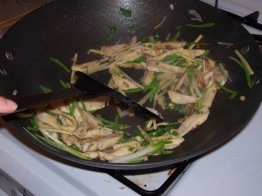
This weekend I took my new Chinese cookbook, The Chinese Kitchen by Eileen Yin-Fei Lo, for a test drive. So far, so good.
When Joe and I were first dating back in Pittsburgh, he was a vegetarian. (I’m a bad influence on vegetarians, what can I say?) Back then stir-fries were a cheap, quick staple. We hadn’t made one in ages, although we’ve lugged our Circulon wok from Pittsburgh to New York to Philly. So we were excited to break it out for the real thing.
I did some grocery shopping before we started this dish– I got really produce-happy at the Reading Terminal Market, and then I went to Chung Kee Asian Supermarket in Chinatown to stock some staples of the Chinese pantry: cooking wine, white rice vinegar, oyster sauce, chili oil, water chestnuts, bamboo shoots, and of course, Pocky. (Which is Japanese, but… Pocky!) We picked up some pork buns, lugged everything home, and got started on a light, healthy meal.
This dish is popular in Shanghai and Hong Kong, according to Lo. I find that a lot of my favorite dishes are Hong Kong-ese, which makes sense when you remember that Hong Kong, like New York, Beirut and Mumbai, is one of the world’s great cultural crossroads. Throw lots of people from many different cultures and foodways together in one place, and amazing new innovations are pretty much guaranteed to happen in the kitchen.
This particular dish has two components: a bird’s nest of crunchy pan-fried noodles, and a topping of stir-fried julienned vegetables, chicken and brown sauce. I picked up some fresh noodles at the Asian supermarket. The main prep work for this dish involves the noodles: you have to boil them very quickly, then let them drain for about two hours until they’re totally dried out. You also have to marinate the chicken for about half an hour, in a mixture of sugar, salt, pepper, cornstarch, sesame oil, rice vinegar, cooking wine, and soy sauce. While that’s happening, you can julienne your water chestnuts, fresh snow pea pods, and bamboo shoots (although you can also buy those pre-julienned).
All of the cooking happens in about five minutes, and it’s really fast, so your mise en place is important here. Everything has to be ready to go. Your garlic and ginger had better be minced, your veggies better be julienned, your sauce better be mixed and ready to go. I did mine right in the measuring cup– 1 cup of chicken stock plus shots of oyster sauce, cooking wine, vinegar, sugar, salt, cornstarch, sesame oil, pepper, and my new favorite condiment, dark mushroom-flavored soy sauce. I bought Pearl River Bridge brand for about $1.75, and it’s amazing– dark and thick, more like balsamic vinegar than any soy sauce we’re used to in the US. It actually coats the back of a spoon. And the flavor is dark and intense– oh, this is definitely going to be a staple.
Now here’s the tricky part: the noodles and the wok need to be going at pretty much the same time. We used teamwork: Joe did the noodles and I was on the wok. The noodles are easy enough: heat oil in the cast iron pan (the recipe calls for peanut, but we used safflower, which has a similar smoke point) until it starts to smoke, then put the big nest of noodles in and fry for about two minutes on each side, moving the pan around so it browns evenly. In the wok, heat oil until smoking. Then add ginger, then garlic, then the chicken. Give that a couple of minutes, then add the veggies. When they soften, pour in your sauce and toss the whole thing around for a while until the sauce thickens up.
Put the noodles on a serving plate, and pour the entire chicken-veggie mixture over it so that the sauce seeps down into the noodles. Slice the whole thing like a pie and eat with chopsticks. We served it with a cold Hedonism Red Ale from Legacy Brewing Co.
We were really happy with this dish. It’s light and flavorful, and it’s got a few different textures going on: crunchy noodles on the outside, softer noodles inside, crunchy veggies, juicy chicken. The fresh snow peas really make the dish. This wasn’t very difficult, and it would be easy enough to make the noodles and chop the veggies a night ahead of time. I’m pretty psyched about having rocked my first Chinese dish!
Next up: Siu mai (pork and shrimp basket dumplings)!
Leave a comment










